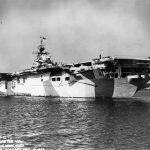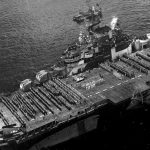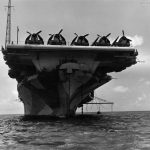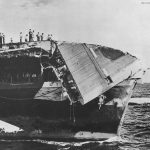USS Hornet at Norfolk Navy Yard, December 1943
USS Hornet color photo
Servron 6 Ammo Ship Replenishing USS Hornet at sea
scoreboard on USS Hornet August 28, 1944
Carrier USS Hornet during the presentation of awards to members of the crew and embarked Air Group Two on August 26, 1944
Hellcats on Flight Deck of USS Hornet 1944
F6F Hellcats of VF-17 returning to aircraft carrier USS Hornet after raid on Nansei Shoto 1945
Direct hit on A6M of 6th Tsukuba Squadron during attack off Okinawa on May 14, 1945. Photo taken from the USS Hornet Carrier in center of photograph is USS Bennington.
Crew Inspects Damage to Carrier USS Hornet after Typhoon june 5, 1945
ServRon 6 Ammo Ship Replenishing USS Hornet CV-12 1944
Launch of U.S. Navy Aircraft Carrier USS Hornet CV-12, 30 August 1943
The eighth USS Hornet (CV/CVA/CVS-12) was originally named USS Kearsarge, but renamed in honor of the CV-8, which was lost in October of 1942. She is nicknamed “The Grey Ghost”.
The contract to build Kearsarge had been given to Newport News Shipbuilding on 9 September 1940, and her keel was laid down 3 August 1942. The seventh Hornet (CV-8) was sunk in the Battle of Santa Cruz on 26 October 1942, and the CV-12 hull was renamed Hornet (the name Kearsarge is still stamped into her keel plate). She was launched 30 August 1943 and commissioned 29 November 1943. Its first commander was Captain Miles M. Browning.
In 1991, Hornet was designated a National Historic Landmark, and on 17 October 1998, she was opened to the public as an aircraft carrier museum at the former Alameda Naval Air Station in Alameda, California.










